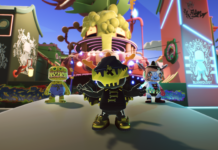I must make a confession: I didn’t quite ‘get’ the first Assassin’s Creed. While I appreciated all of the work that clearly went into producing the title, at the end of the day I found myself bored in some places and confused in others. It’s one of those ‘not you but me’ situations. On paper, I should’ve loved the title, and yet, for some reason it never clicked. It's a solid and enjoyable game, don’t get me wrong, but not my cup of tea no matter how may sips I took. The sequels piqued my interest a bit more, but I could never shake the feeling that, for whatever reason, the games just weren’t for me no matter how badly I wanted them to be.
After attending Ubisoft’s preview event for the recently announced Assassin’s Creed III, I can guarantee you that even I, a sort-of/wish-I-were AC fan, will be first in line to pick it up — and I haven’t even gotten to play it yet.

Assassin’s Creed III is notably set in the midst of the American Revolution — Northeast US to be specific. Whereas previous games relied heavily on crowd-interaction and large cities, this newest entry features a heavy focus on wilderness exploration. The Frontier is being built as a dynamic sprawling world with cliffs to climb and trees to hop around on. New game mechanics, such as two-handed climbing control schemes, are being built to meet the demands of these new environments.
As Developers shared footage and production background on the title, they discussed what they hope will be a true first for a game of this nature: wilderness as an open sandbox. Most games, the developers noted, use wilderness as a background painted under what is ultimately a linear path. In Assassin’s Creed III trees aren’t just landmarks to walk around, but rather a fully interactive part of a giant playground. And fans of city-exploration needn’t worry, as the game has fully featured colonial New York and Boston, as well as a brief visit to parts of Philadelphia, to play in.
The dynamic, new setting presents new challenges for both developers and players. Ubisoft has gone to great lengths to make sure that the player’s interactions with the environment is realistic, from motion-capture of actual rock climbers to creating scale models of each setting early in the game’s development. Tree parkour plays a large role in this game, and players can choose to navigate the trees however they choose. The game features shifts in seasons that bring with them new types of weather to deal with. Snow plays a major role in the game, changing the landscape and affecting the speed and maneuverability of characters. In the footage screened, players and NPCs were both hindered by thick slush, which could prove to be a benefit to players who prefer to climb trees and strike their enemies from above. Other weather effects include fog that affects the player’s field of vision, and rainstorms that affect surfaces and maneuverability. And, of course, being in the wild players will be met with challenges by animals as well. Bears and wolves, among other animals, freely roam and don’t always take kindly to you running around their homes.
Players won’t be spending all of their time wandering the woods, though. As previously mentioned, New York, Boston, and parts of Philadelphia are all in the game as well. The total size of the world is said to be 1.5x the size of Rome in Assassin’s Creed Brotherhood. Players will meet the likes of George Washington and Ben Franklin, but don’t expect to be alligning yourself with either side of the revolution. The American Revolution, Ubisoft made clear, is as important to Americans as it is to the rest of the world. There is a sense of global importance here — universal themes that are key to the game’s story, but at the same time, this is an Assassin’s Creed title. Ultimately, the revolution is merely an exciting new backdrop to work with.

As always, historical accuracy is paramount; this time around, Ubisoft has gone even further out of their way to make sure that the game is as true to the historical period as possible, while still providing an engaging narrative that spans a period of over thirty years. 80% of the characters in the game are real people, and great strides have been taken to ensure they are all multifaceted and not reliant on clichés. This is especially true for the portrayal of the Native American Mohawk tribe in the game, of which the player will be a member.
Replacing Ezio and Altair is new shiny new protagonist Ratohnhaké:ton. Don’t worry about pronouncing that one because he’s mostly referred to as his adopted name: Connor. The game introduces the half-European half-Mohawk anti-hero who has joined the Assassin’s ranks after his tribe was decimated during the war. Connor is far from a Native palette swap over Ezio, though. Where Ezio was the loveable bad-boy, Connor is the nice-guy with a drive for justice and a need to do good in the world. His design is a combination of traditional white AC-garb and period-appropriate accessories that he brings as a part of his culture. Ubisoft worked with consultants to make sure they didn’t rely on stereotype or cliché when including Native cultures in the game. Even Connor’s voice actor is Native American himself; Bill Rogers is a member of the Blackfoot tribe, and in what is sure to be a gaming first, actual Mohawk dialogue will be heard in game. Certain elements, like scalping for instance, were cut during production because ultimately they were not historically accurate (and in the case of scalping, much more gruesome than the developers wanted). There was an ongoing debate over ‘how Native American’ he looked, and while that mere statement is incredibly problematic, it can’t be denied that Ubisoft has been very careful not to fall into the easy trap of cultural appropriation.
Towards the end of the event, a month-old (read: most recent build of the game there is) playable demo was screened. We begin in 1774. Connor is seen trudging through the snow before he is attacked by a black bear. He then proceeds to take down some traveling redcoats. Cut to him wandering through the harbors of New York City, one can see a real living-breathing city happening around them; from paperboys to beggars to soldiers keeping their eye on you. Speaking of eyes, later in the demo, Connor is present for James Briggs’ ‘White of their eyes’ speech before being dropped into the midst of the Battle of Bunker Hill. At this point, the developers touted the game’s ability to render over 3,000 characters on screen at once: a must for a game set during a war. At the end of the demo, Connor took down a group of troops with his bow, musket, and tomahawk before being pulled into the newly designed White Room and out of the demo.

Even with close to a year of development to go and three years of development behind them — the longest for any game in the series — Assassin’s Creed III already has a level of polish that must be lauded. The menu system is gorgeous, keeping the same sleek design aesthetic of the Animus but taking it to the next level by presenting it in 3D space. While human interaction has been lessened in favor of wilderness exploration, the humans in the game have all been revamped with more interactions and relationship opportunities. The game features twice the production capacity of the entire Ezio Trilogy (ACII, Brotherhood, and Revelations) and despite being the fifth title in a major franchise, there is very little recycling being done here. All of the character animations are being built from the ground up, with the only exceptions being iconic movements like the signature Leap of Faith. The production trailer opened with live-action footage and seamlessly transitioned into in-game landscape footage; the game is just dang pretty to look at.
To ensure this already polished-gem is as shiny as possible before release, the developers are hoping to do some kind of Beta release so that when game hits shelves this Fall, the hope is for it to be Assassin’s Creed 3.5 — a complete game and not just a first draft.
Assassin’s Creed III is not just another sequel or spin-off; it’s an entirely new game that builds on what’s come before while also raising the stakes and trying new things. From new game mechanics to the new setting, this title is looking to keep things fresh and will no doubt have plenty of surprises along the way to keep players on their toes. I personally cannot wait to get my hands on a playable demo. Assassin’s Creed III, even at this early stage, looks like it will not only please longtime fans of the series, but also be a perfect jumping on point for both newcomers and people (like me) who weren’t hooked the first time around.
Assassin’s Creed III drops October 30, 2012 for PS3, Xbox 360, Windows, and Wii U.










